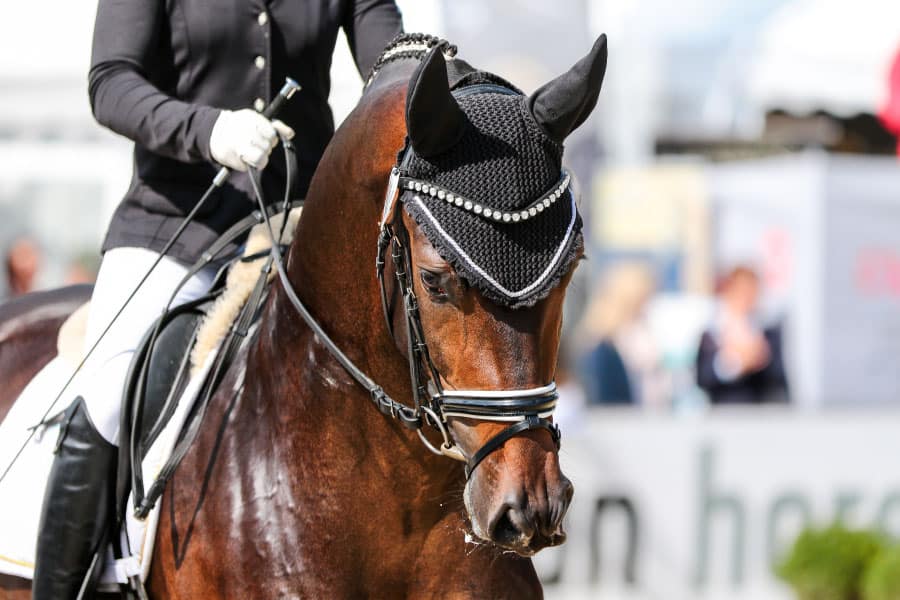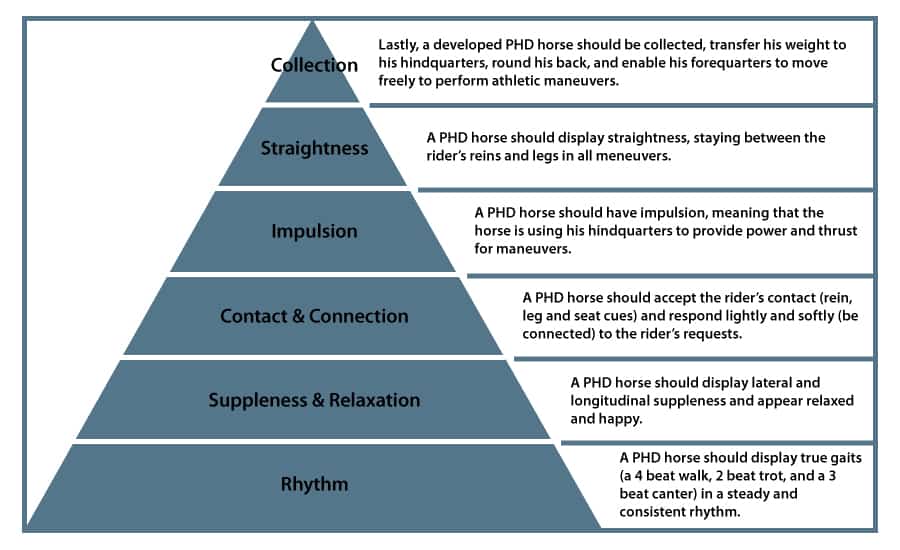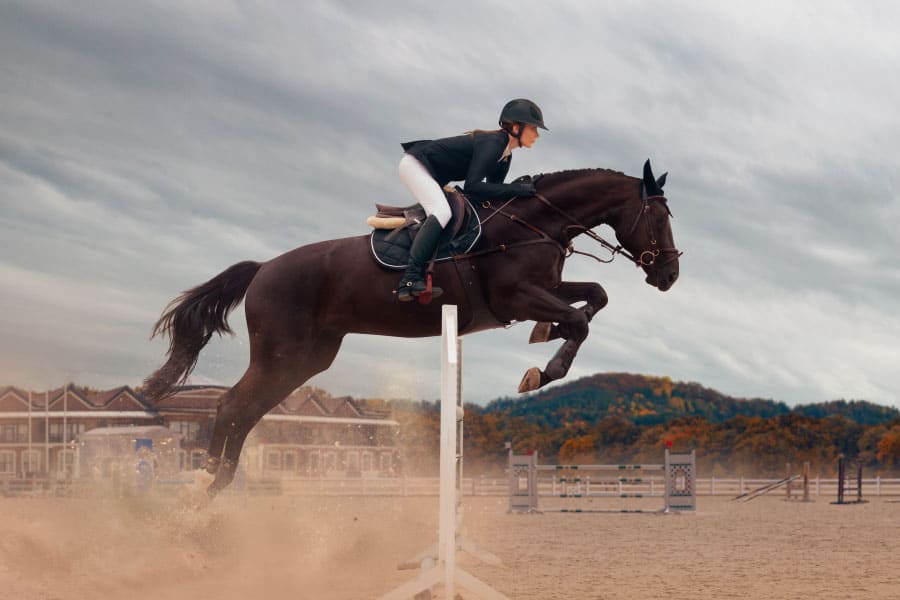- Your source for stall mats, rubber arena footing, arena harrows and arena dust control.

When riding in the Dressage arena, do you ever wonder if Showjumping would be a better or easier discipline? Or when going over jumps, don’t you wonder if the relaxed atmosphere of Dressage is more appealing? Both disciplines are unique but, at the same time, share a lot in common.
Dressage and Jumping are quite different disciplines, each with their own challenges. Dressage is the ‘foundation’ that should be used when training for all the other disciplines. Thus, you cannot compare the two disciplines. Both Dressage and Showjumping are quite technical and exact, which makes them both hard disciplines to master.
By saying Dressage is the ‘foundation’ for training for all the other disciplines, I mean that there are certain aspects in training that need to be achieved before going further in any discipline. These aspects or goals can be achieved through Dressage or Flatwork.
Let’s get into more detail now and clear up any doubts you may have about Dressage or Showjumping to hopefully guide you to the right decision if you are deciding which one to learn.
What is the purpose of dressage?
The definition of dressage is: Dressage is derived from French, that means “Training,” and the purpose for dressage is to build strength and suppleness in the horse, while the horse stays calm and attentive. In a dressage test, both rider and horse is judged on the way they perform a sequence of prescribed movements.
The purpose of training a dressage horse is to produce a fluid moving horse and develop their muscle and mind to have a confident, quiet, responsive, powerful, and more supple horse.
Dressage should be appreciated for the value it contributes to training for any other discipline. When your horse is calm and keen on the flat and in between jumps in a showjumping course, they will ultimately perform better.
You, as a rider, develop better balance and quieter aids when riding and training for Dressage, which is greatly beneficial for Show Jumping. Jumping is basically flatwork except for the part when the horse is going over the fence. Basics such as waiting, going forward, going sideways, and adjustability are still all part of Dressage.
Dressage has a ‘Training Scale’ that is most widely used for training and mastering this discipline, as can be seen below.

Here are some aspects of that scale as well as how these aspects affect your jumping:
Rhythm
Your horse should have a steady rhythm at all 4 gaits; walk, trot, canter, and gallop. When your horse struggles to maintain rhythm in the walk, they will naturally struggle with a proper rhythm at the trot and so on. Rhythm and consistency is key to a good jumping round.
Suppleness and relaxation
A relaxed horse is a happy horse and an easier ride. After establishing a rhythm, the horse should achieve suppleness throughout their body and their paces. Rhythm, suppleness, and relaxation will help you when negotiating odd turns and corners in show jumping as well as adjusting your horse’s strides in between related distances and combinations.
Contact
Contact does not just mean being ‘on the bit,’ it means that the horse is steady in hand and responsive to leg and seat aids. The horse responds quickly and lightly to the rider’s ques. In showjumping, a horse that is connected will have a clear understanding of what you are asking and will respond to the ques.
This helps the rider, again, adjust appropriately between the jumps and get those perfect take-off spots. When incorrectly schooled, a horse can quickly become ‘lazy’ or ‘dead off the leg’ and hard in the mouth. The horse can also hang on the rider’s hands, which makes it a fight every time you ride and unpleasurable.
Impulsion
Impulsion means that the horse uses their hindquarters to push themselves forward instead of leaning on the forehand and ‘dragging’ themselves forward. Good impulsion creates a more powerful jump and develops the horse’s hindquarters.
Straightness
Obviously, a horse needs to approach a jump, especially in related distances and combinations straight on. When the horse does not move between the rider’s hands and leg, they will often ‘lose their shoulder’ and lose their straightness.
Straightness only develops after all the previously mentioned goals are accomplished successfully. Straightness will affect the way your horse approaches and lands from a jump, and this, in turn, will determine your striding and maneuverability through a course.
Collection
Lastly, and very importantly, your horse should be able to collect and carry himself and you on his back. By collecting himself, your horse transfers his weight back onto his hindquarters and rounds his back. This frees up the front limbs and moves more freely and easily. A collected horse carries a rider better as well.
A Collected horse is more balanced through their gates, and this prevents stumbling and loss of balance over fences and around tight turns. Your horse will also evenly distribute their weight over jumps and really be able to push off properly over jumps and land better. It is also healthier for a horse to move in a rounded frame, and the risk of kissing spine and lameness decreases.
and lameness decreases.

Training for show jumping
As a showjumper, you can already see the benefit of using Dressage when training a Show Jumping horse. The training scale in Dressage can be used to build up a young horse in show jumping and teach them valuable aspects in the flatwork that will greatly improve your riding in a course, especially in between jumps.
Show Jumping, as stated before, is Dressage with added adrenaline and ‘air-time’ where the horse and rider negotiate big fences, all the while using good flatwork and Dressage to make it easier and healthier for both rider and horse.
Riders position
The rider’s position in show jumping is of paramount importance because the rider’s position will determine how the horse goes through the course.
When you have the optimal rider position, you should be, and feel, completely in balance in the saddle. You should be able to move freely with the horse and balance all your weight in the stirrups. And, most importantly, not interfere with the horse’s balance when they are going over the jump.
Dressage needs a longer leg position and a deep-seated position in the saddle. In contrast, with Showjumping, the rider needs to have shorter stirrups and a shorter leg position to stand up and out of the saddle to allow the horse to jump as well as have a lighter seat position overall.
For more on the differences in riding position between Dressage and Showjumping, feel free to check out my post on “Can You Jump in a Dressage Saddle? “
“
But when riding a ‘hot’ horse or a horse that tends to hang down, having a deep-seated position in the saddle in show jumping is needed and can help slow the horse down or get the horse to shift their weight onto their back legs.
Sitting quietly in the saddle and not throwing your weight around is another basic that is taught in Dressage and used in Show Jumping. This allows both the horse and rider to be in balance.
Conclusion
It is thus safe to say that Dressage is a basic need and aspect for all show jumpers and that all riders need to respect that. When the rider takes ‘short cuts,’ it will only result in lousy riding and bad jumping skills. Both horse and rider can benefit from doing and mastering Dressage to improve and master show jumping.
A good coach also addresses the importance of dressage in everyday training. This is also why one cannot compare Dressage to Jumping and point out which one is harder than the other. Both disciplines are technical and have their own elements that make them not only an amazing sport but also a difficult discipline to master in their own right.

